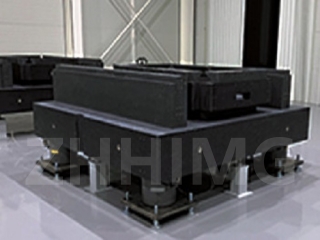Granite and marble are both popular choices for precision components in various industries, particularly in precision measurement and machining. However, there are significant differences in their physical stability that can greatly affect their use in these applications.
Granite is a common choice for precision components due to its exceptional physical stability. It is a dense and hard igneous rock that is formed from the slow crystallization of magma beneath the Earth's surface. This slow cooling process results in a uniform, fine-grained structure that gives granite its exceptional strength and stability. In contrast, marble is a metamorphic rock that is formed from the recrystallization of limestone under high pressure and temperature. While marble is also a durable and visually appealing material, it lacks the physical stability and strength of granite.
One of the significant differences in physical stability between precision granite components and marble precision components is their resistance to deformation. Granite has a very low coefficient of thermal expansion, meaning it is highly resistant to changes in temperature. This makes it an ideal material for precision components that require dimensional stability over a wide range of temperatures. On the other hand, marble has a higher coefficient of thermal expansion, making it more prone to dimensional changes with fluctuations in temperature. This can be a critical factor in precision measurement and machining, where even the slightest dimensional changes can lead to inaccuracies and errors.
Another important difference is their resistance to wear and abrasion. Granite is highly resistant to wear and abrasion, making it suitable for precision components that are subjected to constant friction and contact. Its hardness and durability ensure that it maintains its dimensional accuracy over time, even under heavy use. Marble, while still a durable material, is not as resistant to wear and abrasion as granite. This can be a concern in precision machining applications where the components are constantly in contact with other materials, as the potential for wear and deformation is higher with marble components.
In precision measurement and machining, the differences in physical stability between granite and marble components can have a significant impact on the accuracy and reliability of the processes. Precision measurement instruments, such as coordinate measuring machines and surface plates, rely on the stability and flatness of the components to ensure accurate and repeatable measurements. Granite's superior physical stability makes it the preferred choice for these applications, as it provides a stable and reliable foundation for precise measurements. On the other hand, the lower stability of marble components can lead to inaccuracies and inconsistencies in measurements, compromising the quality of the results.
Similarly, in precision machining, the physical stability of the components is crucial for achieving tight tolerances and high-quality finishes. Granite is often used for machine bases, tooling, and fixtures in machining applications due to its exceptional stability and resistance to vibration. This stability is essential for maintaining the accuracy of the machining process and ensuring the quality of the finished products. Marble, with its lower stability, may not be suitable for these applications as it can introduce unwanted vibrations and dimensional changes that affect the precision and quality of the machined parts.
In conclusion, the significant differences in physical stability between precision granite components and marble precision components have a direct impact on their use in precision measurement and machining. Granite's exceptional stability, resistance to deformation, and durability make it the preferred choice for precision components in these applications. Its ability to maintain dimensional accuracy and stability over a wide range of temperatures and under constant wear and abrasion makes it an ideal material for precision instruments and machining components. On the other hand, while marble is a visually appealing and durable material, its lower stability and resistance to wear and abrasion make it less suitable for precision applications where dimensional accuracy and stability are paramount. Understanding these differences is crucial for selecting the right material for precision components to ensure the accuracy, reliability, and quality of precision measurement and machining processes.
Post time: Sep-06-2024

